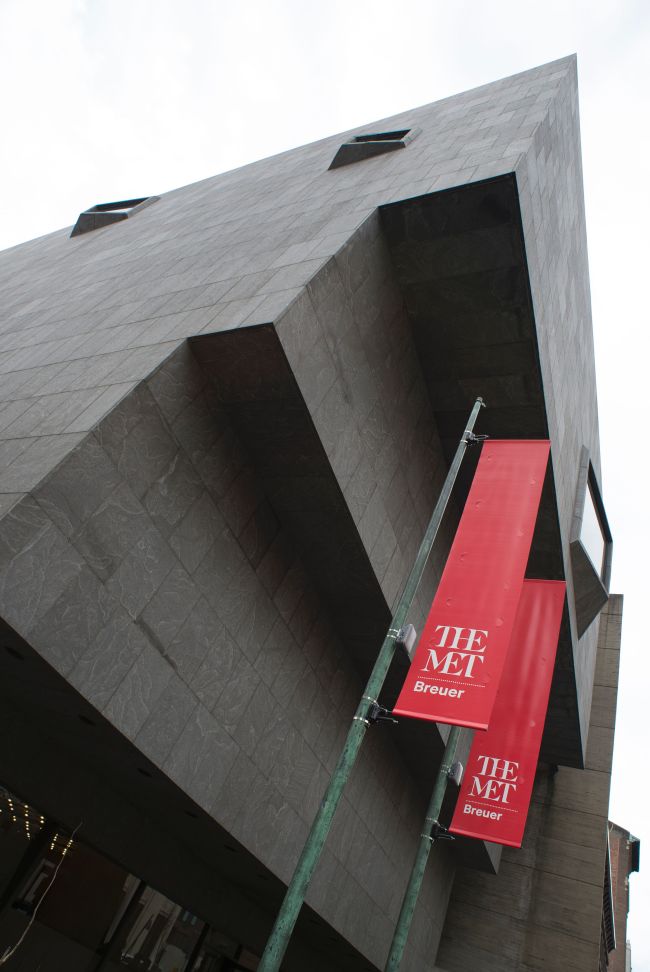NEW YORK (AFP) - New York is adding to its glittering portfolio of art museums with a new gallery dedicated to modern and contemporary art -- The Met Breuer, which opens with a retrospective of a little known Indian artist.
The gallery is housed in the modernist icon that Hungarian-born Bauhaus architect Marcel Breuer built in 1966 on Madison Avenue for the Whitney Museum of American Art, which last year moved downtown to a spanking new site.
When the Breuer opens to the public on March 18, it will become the third site for the famed Metropolitan Museum of Art -- the city's most frequented museum. Last year it welcomed a record 6.3 million visitors to its Fifth Avenue address and Cloisters celebrating Medieval art in northern Manhattan.
The gallery is housed in the modernist icon that Hungarian-born Bauhaus architect Marcel Breuer built in 1966 on Madison Avenue for the Whitney Museum of American Art, which last year moved downtown to a spanking new site.
When the Breuer opens to the public on March 18, it will become the third site for the famed Metropolitan Museum of Art -- the city's most frequented museum. Last year it welcomed a record 6.3 million visitors to its Fifth Avenue address and Cloisters celebrating Medieval art in northern Manhattan.

“This is a masterpiece of mid-century architecture and we are going to be reactivating it with a new curatorial spirit,” Met director Thomas Campbell told reporters, calling it a “significant moment for the city.”
The project is the brainchild of billionaire philanthropist Leonard Lauder, the son of cosmetics legend Estee who has endowed the Met with millions of dollars to further its modern and contemporary art and scholarship.
His gifts plug a gap in the Met’s otherwise rich 5,000 year history of art, even if America's cultural capital is already heaving with contemporary and modern art. Besides the Whitney and a host of smaller galleries, the Museum of Modern Art and the Guggenheim have some of the finest collections in the world.
The Met says the Breuer will compliment, rather than compete with, what’s already on offer by linking the present to its almost unparalleled historical archives.
“What our peers do is show modern and contemporary art in the context of the modern and contemporary. What the Met does, uniquely, is that we have the historical traditions that modern and contemporary artists are either embracing or reacting against,” said Campbell. It's “a different experience,” he added.
That history is on display in one of two inaugural exhibitions: “Unfinished: Thoughts Left Visible” which showcases more than 190 works from the Renaissance to the present that have been seemingly or deliberately unfinished.
Nearly 40 percent of the works come from the Met’s own collection and the rest is on loan from more than 100 lenders, including a Vincent van Gogh canvas from Helsinki and a Titian from the Czech Republic.
- Eye opener -
“I think people will come away from this exhibition very stimulated by the idea that they have been immersed in the world of making art,” said Andrea Bayer, curator in the department of European paintings.
The exhibition, which unites greats such as Rembrandt, Turner and Cezanne with abstract artists such as Jackson Pollock, draws keen parallels between the Old Masters, and the modern and contemporary world.
“They sometimes go off in a different, more conceptual direction but artists are still asking exactly the same questions,” said Bayer.
The other exhibition is the first retrospective in a U.S. museum of Indian artist Nasreen Mohamedi, looking back on her delicate, meditative art from the beginning of her career in the 1960s until her death in 1990.
Born in Karachi, which is today in modern-day Pakistan, she grew up and worked in India, but remained obscure throughout her lifetime.
“It's a giant step for us,” said Kiran Nadar, a prominent Indian art collector who owns several Mohamedi works in the exhibition and who six years ago opened the Kiran Nadar Museum of Art New Delhi.
“Indian art is perceived as very figurative, so to see abstraction in the purest sense coming out of India is going to be an eye opener for people here,” she added. “I think it’s going to start a new recognition of Indian art.”
Interest in Indian art is on the rise in the West. Mohamedi's work has been shown before in the U.S. Last winter, the Guggenheim mounted a retrospective of Indian modernist V.S. Gaitonde. Other artists have been shown in Europe.
Brinda Kumar, a research assistant at the Met, said there was a need to embrace movements of modernism beyond the Western canon.
“I think exhibitions like this really help in doing that,” she told AFP. “I think people are curious to know, ’well what was going on there? What is going on there?'”







![[Graphic News] More Koreans say they plan long-distance trips this year](http://res.heraldm.com/phpwas/restmb_idxmake.php?idx=644&simg=/content/image/2024/04/17/20240417050828_0.gif&u=)
![[KH Explains] Hyundai's full hybrid edge to pay off amid slow transition to pure EVs](http://res.heraldm.com/phpwas/restmb_idxmake.php?idx=644&simg=/content/image/2024/04/18/20240418050645_0.jpg&u=20240419100350)





![[From the Scene] Monks, Buddhists hail return of remains of Buddhas](http://res.heraldm.com/phpwas/restmb_idxmake.php?idx=652&simg=/content/image/2024/04/19/20240419050617_0.jpg&u=20240419175937)

![[KH Explains] Hyundai's full hybrid edge to pay off amid slow transition to pure EVs](http://res.heraldm.com/phpwas/restmb_idxmake.php?idx=652&simg=/content/image/2024/04/18/20240418050645_0.jpg&u=20240419100350)

![[Today’s K-pop] Illit drops debut single remix](http://res.heraldm.com/phpwas/restmb_idxmake.php?idx=642&simg=/content/image/2024/04/19/20240419050612_0.jpg&u=)